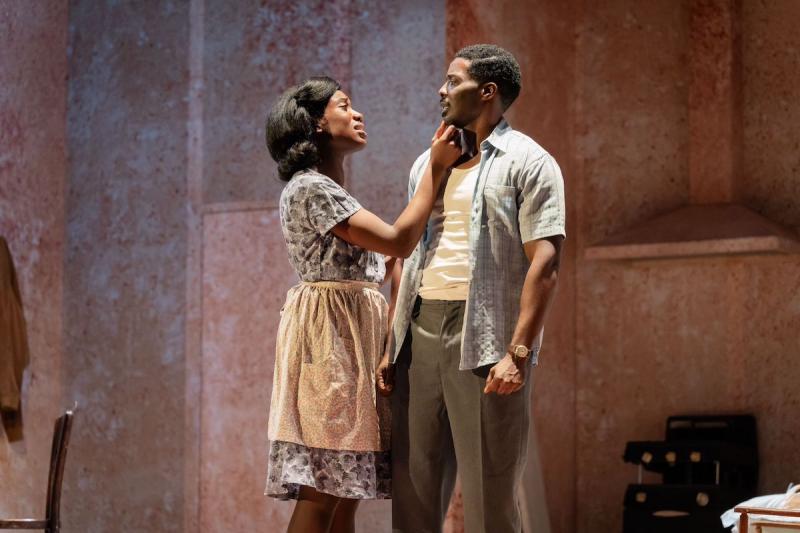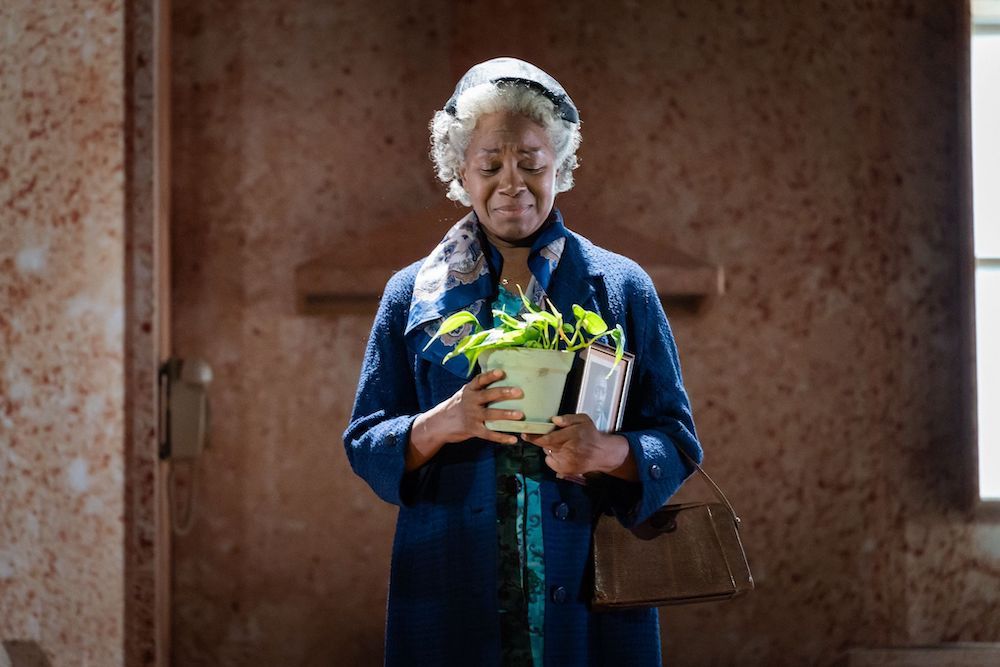A Raisin in the Sun, Lyric Hammersmith review - of race and men | reviews, news & interviews
A Raisin in the Sun, Lyric Hammersmith review - of race and men
A Raisin in the Sun, Lyric Hammersmith review - of race and men
Lorraine Hansberry classic is both a historical gem and a play for today

Lorraine Hansberry’s A Raisin in the Sun is not only the first play by a black woman to premiere on Broadway, back in 1959, but it’s also a cultural goldmine. So powerful is its depiction of the postwar African-American experience that it has inspired at least two other recent dramatic responses: Bruce Norris’s Clybourne Park (2010) and Kwame Kwei-Armah’s Beneatha’s Place (2013).
Watching A Raisin in the Sun’s current staging, directed by Tinuke Craig for Headlong and visiting the Lyric Hammersmith as part of a national tour, it also resonates with other recent 1950s revivals: A Taste of Honey, Waiting for Godot, Roots and Look Back in Anger. Especially Look Back in Anger. In fact, the first act of Hansberry’s drama has all the passionate energy of the Osborne play.
Set, like Look Back in Anger, in a single living room, A Raisin in the Sun examines two dilemmas facing the multigenerational Younger family, whose apartment is in Chicago’s rather impoverished Southside. Having inherited substantial insurance money after the death of Walter senior, his widow Mama decides to move her daughter Beneatha, son Walter, his wife Ruth, as well as her grandchild Travis, to Clybourne Park, a better part of town. But when the white residents of that location object to a black family sharing their street, and offer the Youngers a cash incentive to stay away, the Youngers have to decide whether to accept the cash or contest this blatant racism. Mama’s second dilemma is whether to trust her 35-year-old son Walter, whose dream is to invest his father’s insurance money in a start-up business, a liquor store. Although he works as a chauffeur, he passionately wants to better himself. But can Mama trust him with the family money? If she doesn’t his dream will die. As the Langston Hughes poem, which is recited at the start of this production, goes: “What happens to a dream deferred?/ Does it dry up/ Like a raisin in the sun?/ Or fester like a sore – ” Or, as Hughes concludes, “does it explode?” Given Walter’s mercurial nature and high emotions, this final option sounds increasingly likely.
Mama’s second dilemma is whether to trust her 35-year-old son Walter, whose dream is to invest his father’s insurance money in a start-up business, a liquor store. Although he works as a chauffeur, he passionately wants to better himself. But can Mama trust him with the family money? If she doesn’t his dream will die. As the Langston Hughes poem, which is recited at the start of this production, goes: “What happens to a dream deferred?/ Does it dry up/ Like a raisin in the sun?/ Or fester like a sore – ” Or, as Hughes concludes, “does it explode?” Given Walter’s mercurial nature and high emotions, this final option sounds increasingly likely.
Walter is Hansberry’s Angry Young Man. Like Jimmy in Look Back in Anger, his energy and sense of frustrated life electrify the stage, and his relationship with his wife Ruth gives off sparks as he believes that she no longer understands him, while she sees his aspirations and potential business-partner friends as reckless and unreliable. Besides, she and Mama not only want to use the insurance money to move to a better neighbourhood – free they hope of cockroaches, and with some sunlit windows – but also for Beneatha’s further education. For this young woman wants to study to be a doctor, to help other people.
Beneatha is fascinating. She represents an early, and prescient, image of black power and black pride (Hansberry was one of the first creatives to be called “young, gifted and black”), and her desire to explore her racial and emotional identity, although mocked by other family members, is clearly articulated, and also expressed in her relationships with two suitors. The first, George Murchison, comes from a well-off African-American family, but desires a compliant wife; the second, Joseph Asagai, is a Nigerian radical who wants to return to Africa, fight for independence and build a new black society based on social justice. Like Beatie in Arnold Wesker’s Roots, Beneatha gradually finds her own voice.
In this 1950s kitchen-sink drama, the shadow of Look Back in Anger looms not only over the scruffy setting, with its onstage ironing board and overcrowding, but also in some of the speeches. Walter is an Angry Young Man who mistreats his wife, but he also echoes Jimmy’s “good, brave causes” speech when he proclaims “There ain’t no causes – there ain’t nothing but taking in this world”. Hansberry also riffs on Osborne’s newspapers and his mention of nuclear weapons. Similarly, Mama’s speech about love, how the test of feeling is when your lover is at their “lowest”, echoes not only Jimmy, but also Arthur Miller at his most compassionate best. It’s a great piece of playwriting.
As Spike Lee says in the playtext of the Young Vic revival in 2001, which starred Lennie James and Cecilia Noble, “Like all great works of art, this stuff doesn’t get old.” What does age is some of the racial language, which feels rather uncomfortable today, but Lee is right: the main themes of racial inequality, racial identity, class difference, masculinity (whether toxic or in crisis), the thrill of jazz music, and generational difference in a black family, remain thrillingly relevant. They shout out from the stage. In particular, Walter’s passion for self-betterment (American Dream), and Beneatha’s unwillingness to assimilate her identity (Afrocentrism) into society’s norms, are loud and clear.
Hansberry’s writing, with its mix of humour and tragedy, both underpinned by a deep humanity and symbolism (such as the show’s title and Mama’s love of a stunted plant), are lucidly reproduced by Craig’s staging, a co-production with the Leeds and Nottingham playhouses, although designer Cécile Trémolières’s set feels awkward in its starkness. Still, the cast deliver powerful performances, led by Solomon Israel’s Walter and Cash Holland’s Ruth, who are convincing in their love and antagonism. His performance in particular embraces both cool satire and hot emotionality. Doreene Blackstock’s matriarchal and dignified Mama (pictured above) is beautifully realized, and the episodes with Joséphine-Fransilja Brookman’s lively Beneatha give Gilbert Kyem Jr’s George and Kenneth Omole’s Joseph lots of room to shine. Which they all do. Yes, this revival is both a historical gem and a play for today.
rating
Explore topics
Share this article
The future of Arts Journalism
You can stop theartsdesk.com closing!
We urgently need financing to survive. Our fundraising drive has thus far raised £49,000 but we need to reach £100,000 or we will be forced to close. Please contribute here: https://gofund.me/c3f6033d
And if you can forward this information to anyone who might assist, we’d be grateful.

Subscribe to theartsdesk.com
Thank you for continuing to read our work on theartsdesk.com. For unlimited access to every article in its entirety, including our archive of more than 15,000 pieces, we're asking for £5 per month or £40 per year. We feel it's a very good deal, and hope you do too.
To take a subscription now simply click here.
And if you're looking for that extra gift for a friend or family member, why not treat them to a theartsdesk.com gift subscription?
more Theatre
 Hamlet, National Theatre review - turning tragedy to comedy is no joke
Hiran Abeyeskera’s childlike prince falls flat in a mixed production
Hamlet, National Theatre review - turning tragedy to comedy is no joke
Hiran Abeyeskera’s childlike prince falls flat in a mixed production
 Rohtko, Barbican review - postmodern meditation on fake and authentic art is less than the sum of its parts
Łukasz Twarkowski's production dazzles without illuminating
Rohtko, Barbican review - postmodern meditation on fake and authentic art is less than the sum of its parts
Łukasz Twarkowski's production dazzles without illuminating
 Lee, Park Theatre review - Lee Krasner looks back on her life as an artist
Informative and interesting, the play's format limits its potential
Lee, Park Theatre review - Lee Krasner looks back on her life as an artist
Informative and interesting, the play's format limits its potential
 Measure for Measure, RSC, Stratford review - 'problem play' has no problem with relevance
Shakespeare, in this adaptation, is at his most perceptive
Measure for Measure, RSC, Stratford review - 'problem play' has no problem with relevance
Shakespeare, in this adaptation, is at his most perceptive
 The Importance of Being Earnest, Noël Coward Theatre review - dazzling and delightful queer fest
West End transfer of National Theatre hit stars Stephen Fry and Olly Alexander
The Importance of Being Earnest, Noël Coward Theatre review - dazzling and delightful queer fest
West End transfer of National Theatre hit stars Stephen Fry and Olly Alexander
 Get Down Tonight, Charing Cross Theatre review - glitz and hits from the 70s
If you love the songs of KC and the Sunshine Band, Please Do Go!
Get Down Tonight, Charing Cross Theatre review - glitz and hits from the 70s
If you love the songs of KC and the Sunshine Band, Please Do Go!
 Punch, Apollo Theatre review - powerful play about the strength of redemption
James Graham's play transfixes the audience at every stage
Punch, Apollo Theatre review - powerful play about the strength of redemption
James Graham's play transfixes the audience at every stage
 The Billionaire Inside Your Head, Hampstead Theatre review - a map of a man with OCD
Will Lord's promising debut burdens a fine cast with too much dialogue
The Billionaire Inside Your Head, Hampstead Theatre review - a map of a man with OCD
Will Lord's promising debut burdens a fine cast with too much dialogue
 50 First Dates: The Musical, The Other Palace review - romcom turned musical
Date movie about repeating dates inspires date musical
50 First Dates: The Musical, The Other Palace review - romcom turned musical
Date movie about repeating dates inspires date musical
 Bacchae, National Theatre review - cheeky, uneven version of Euripides' tragedy
Indhu Rubasingham's tenure gets off to a bold, comic start
Bacchae, National Theatre review - cheeky, uneven version of Euripides' tragedy
Indhu Rubasingham's tenure gets off to a bold, comic start

Add comment